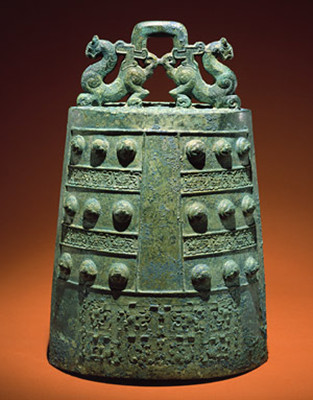By European standards, these ancient Chinese bronze bells are enormous.
按歐洲的標準來看,這些中國銅鐘的體型過于巨大。
Nothing on this scale would be cast in Europe until the Middle Ages, over fifteen hundred years later.
直到一千五百多年后的歐洲中世紀,歐洲人才制造出與其規模相當的物品。
But the role of bells in China could go far beyond the musical.
但鐘在中國的作用遠不只奏樂這么簡單。
To produce perfect tones they had absolutely standardised shapes, and the consistency of these shapes meant that the bells could also be used to measure volume.
為了校正出完美的音調,鐘的形狀必須標準化,
You had, so to speak, a pint bell or a quart bell.
因而可以用于測量標準容積。
And as the amount of bronze in each one was also carefully controlled, they could just as well provide standard weights.
此外,制作銅鐘所使用的青銅數量也是固定的,
So you could have, as it were, a hundredweight bell, and so on.
于是也可成為重量標準。
So there is a sense in which a set of bells in ancient China could also serve as a sort of local weights and measures office, bringing harmony to commerce as well as society.
古代中國的一套銅鐘,演奏之余還可以充當當地政府的度量衡工具,使商業與社會和諧。
Intriguingly, bells also played a major roll in the etiquette of war.
有趣的是,戰爭禮儀也需要銅鐘。
The Chinese held that no attack could be considered fair and above board without the sounding of bells or drums, from then on you could honourably fight without restraint.
中國人認為,不奏響鐘鼓便發動的攻擊不是公平正義的戰爭,而鐘鼓奏響之后便可大戰一場。
But more commonly, the bells were used for rituals and entertainments at court, played at grand occasions, banquets and sacrificing ceremonies, the complex music of the bells marked the rhythm of court lives.
不過,銅鐘還是更多地用于宮廷儀式與娛樂活動。在重大場合、宴會和宗教儀式上,銅鐘奏響的復雜音樂標記了宮廷的生活步調。
The bells, and the ancient methods of playing them, travelled well beyond the boundaries of China, and the closest surviving form of this ancient music is today found not in China, but in Korean court music that originated in the twelfth century-and is still played in Korea now.
銅鐘及其古老的演奏方式也傳到了中國境外。如今流傳下來的最接近古代的演奏方式不在中國,而在朝鮮半島:從十二世紀出現起便一直流傳至今的朝鮮宮廷音樂。












